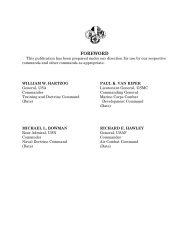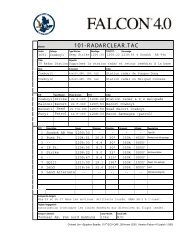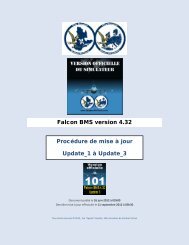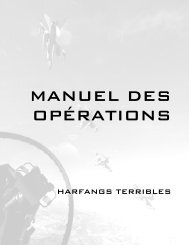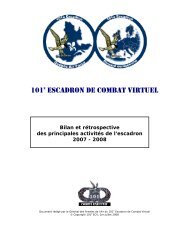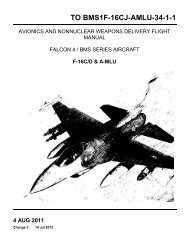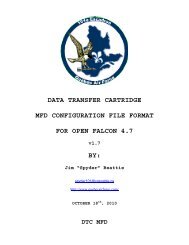PRESS Release
PRESS Release
PRESS Release
You also want an ePaper? Increase the reach of your titles
YUMPU automatically turns print PDFs into web optimized ePapers that Google loves.
Québec Air and Space Hall of Fame - 2006 EditionAnnette (1909-1997) and Géralde (born in 1911) Brunelle. Two sisters, members in 1939 of thefirst air stewardess class in Canada. More than 1000 women applied on the competition held by TransCanada Air Lines (now Air Canada), for about only fifteen open positions. Among hiring conditions,candidates had to be certified nurses, single, with a mandatory resignation clause upon mariage. Startingon 10-passenger Lockheed 10A Electras (unpressurized and unable to fly high enough to avoid badweather and turbulence), the presence of a nurse as a crewmember helped passengers feel secure andprovided expertise to handle discomforting situations, a reality of early commercial flying. Pioneers intheir own right, the Brunelle sisters and their colleagues built the foundations of a new profession,essential to later development of commercial aviation.Madeleine Deshaies (born in 1952). First and only woman in history appointed (in 2004) member ofthe ICAO Air Navigation Commission. This 15 member-commission includes some of the best technicalexperts in the world and sets international standards. Highly respected by her peers, she started in1976 as flight instructor at the Sorel (Qc) flying club. Between 1978 and 1981 (before age 30), shemoved from head instructor to chief-pilot at Air Dorval, at a time when aviation was still very much amale-dominated profession. Between 1981 and 2003 at Transport Canada, she was Inspector (AirRegulations), Superintendant (Airspace and Aerodromes), Regional Director (Aviation Enforcement) andRegional Manager (Civil Aviation).Hugh P. Illsley (1896-1992) CG. World War One Montreal-born flyer, decorated with the FrenchCroix de guerre (received from the hands of General Foch). As a civilian, «Pete» Illsley remainedinvolved with military aviation throughout his life, especially with the youngsters. In 1941, he cofounded(with Willam A. «Billy» Bishop and Georges B. Foster) the Air Cadet League of Canada andformed the first squadron (No.1 Westmount), which he commanded until 1948. In 1958, he becameNational President of the League, remaining afterward on the Advisory Board until his death threedecades later. He donated to the League a trophy (today the H.P. Illsley Trophy) awarded to the bestdrums and bugles band. A well-known architect, his firm designed in the 1950’s the original plans of theDorval terminal (today Pierre Trudeau airport).Domina Jalbert (1904-1991). Born in St-Michel-des-Saints (Qc), educated at College Saint-Josephof Berthier, his family mooved to Woonsocket (Rhode Island). He obtained his private pilot license in1927. Growing up with a passion for kites, he invented in the 1930’s the «kytoon» (from «kyte» and«balloon»). During the war, he designed barrage balloons that defended London against air attacks. In1949, he founded Jalbert Aerology Laboratory. In 1963, he invented the «parafoil», a flexible wing withcells inflated with the airflow to generate lift. Considered by some as the most radical departure inparachute design since Leonardo de Vinci, the parafoil was rapidly adopted by the American parachuteteam Golden Knights. Forerunner of paragliders and traction kites used for paraski and kitesurf, theparafoil was also tested by NASA for manned space vehicules reentry.Kenneth M. Molson (1916-1996). Born in Montreal, he learned to fly in 1936 at the Curtiss-ReidFlying School in Cartierville and studied at the Boeing School of Aeronautics in California. During thesummers of 1935-36, he worked as a mechanic for Dominion Skyways in Rouyn. Until 1959, he waswith Avro Aircraft, working primarily in engineering on such projects as the Arrow. Recognized as thebest Canadian aviation historian, he wrote many periodical articles and reference books, such asPioneering in Canadian Air Transport, The First 500 Canadian Civil Pilots, Curtiss HS Flying boats (withA.J. Shortt), Canadian Aircraft since 1909 (with H.A.Taylor), 125 years of Canadian Aeronautics (withG.Fuller and J.A.Griffin). Key figure behind the creation in 1960 of the Canada Aviation Museum inOttawa, he was the first curator and remained in position until 1967. In 1974, he won the prestigiousAmerican Aviation Historical Writers Award.Page 2/3
Harry S. Quigley (1888-1929) MC, DCM. Born in Toronto, he served during the First World War withground troops (twice decorated) before becoming a fighter and seaplane pilot in the RFC. Involved withpostwar operations leading to the opening in 1920 of the Canadian Air Force hydrobase in Roberval, hewas hired by Price Brothers papermills in Chicoutimi to organize one of the earliest forestry patrol airservices. Operations began the same year, flying Martinsyde floatplanes. In 1922, the service becameindependent, bearing the name Dominion Aerial Exploration Co. Bases were established in Roberval,Trois-Rivières, Montréal, Sept-Iles and elsewhere. In 1926, wishing to diversify operations and not limititself to photographical works, the company was renamed Canadian Airways, thus consolidating itspioneering status in early commercial aviation. President and Chief-pilot, Quigley was also one of theoriginal airmail pilots. The company was later acquired by a group headed by James Richardson tobecome part of the first major airline in Canada created in 1930, which kept the name Canadian Airways.Wilfrid T. Reid (1887-c.1954). British engineer who started in England for the Royal Aircraft Factoryand was chief designer at Bristol Aeroplane in the early 1920’s. In 1924, he became chief designer of theaeronautical department at Canadian Vickers in Montreal (then the only aircraft manufacturer in Canada).Reid developped the highly successful Vickers Vedette, which marked the true beginning of theCanadian aircraft industry. The prototype was tested in a wind tunnel, another first in Canada. Reidthen designed the Vickers Vanessa, Vista, Vigil, Velos, Varuna and HS-3L. In February 1928, hefounded Reid Aircraft, which acquired the airfield in Cartierville. Reid designed the Rambler, a trainerplane that acheived fair success despite the Depression years ahead. In December 1928, the AmericanCurtiss company invested in the project, giving birth to the Curtiss-Reid Aircraft company, a well-knownname in the Canadian aviation scene until the 1950’s. A coin was issued by the Royal Canadian Minthonouring W.T. Reid and the Vickers Vedette.Pierre Rivest (1928-2003). Writer in 1960 of the first training manual in French for pilots, titled «PleinVol». He also wrote: «Pilote de brousse/Bush pilot», «Manuel de l’instructeur de vol», «Le transportaérien spécial et en régions isolées». In 1968, he elaborated a collegial program for pilots at the Centrequébécois de formation aéronautique (CQFA) in Chicoutimi. Airline and bush pilot, he also worked fifteenyears for Transport Canada as Inspector responsible of flying schools and instructors, RegionalSuperintendant Air Regulations, and project manager for the Amendments to the Aeronautics Act. Duringeight years, he was Director of the Air Transport Division for the Quebec government. He was alsoproject manager at the International Aviation Management Training Institute (IAMTI/IIFGA). Two trophieswere created in his honour. He also received the Queen Elizabeth II medal, the Transport Canada AirSafety Award and the FAI Tissandier Diploma.Father Joseph Thibeault (1888-1977). To compensate for the lack of roads on the North Shore,Father Thibeault opened an airfield in his parish of Grandes-Bergeronnes (near Tadoussac, Qc) andoperated between 1937 and 1948 a humanitarian air service (later called Compagnie d’AviationCharlevoix-Saguenay). Starting with a Travel Air 4000 biplane (piloted by Rodolphe Pagé), the serviceprovided assistance to the sick and wounded, organized transportation of medecine, food supplies, etc.From 1944 on, other types were added: Stearman C3B, Bellanca Skyrocket, DH-82 Tiger Moth and fourwar surplus twin engine Avro Anson V. Offering then regular air services, the company gave rareopportunities to promising young airmen who would later make significant contributions to Quebecaviation (such as Gilles Simard, Charles Fortin, Lucien Lavigueur, Pierre Queneau).Group Induction425 Squadron «Alouettes»Bomber squadron formed during World War II mainly for French Canadian airmen. Posted in North Africaand England, 425 Squadron served with honours and distinction, flying four-engine Wellington andHalifax bombers with oustanding results (2 MBE, 163 DFC, 4 DFC with bars, 2 GM, 18 DFM, 1 DFCUS). The Alouettes squadron provided French Canadians an opportunity, for the first time, to massivelypenetrate the aviation scene. Postwar aviation will greatly benefit from this qualified pool of personneland many former 425 members will later make significant contributions to aviation. Accordingly, theimpact of the 425 outlived its operationnal war service. Disbanded in 1945, the squadron wasreactivated in 1954 at St.Hubert. It is today a fighter unit posted in Bagotville (Qc).Page 3/3



